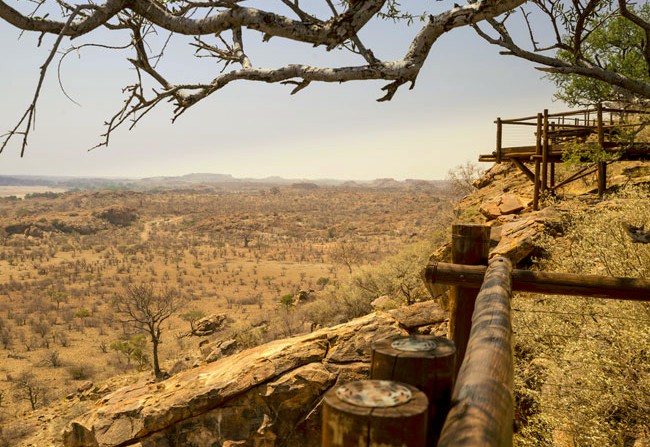Place image

Mapungubwe Cultural Landscape is an open, expansive Savannah Landscape at the confluence of the Limpopo and Shashe Rivers. Mapungubwe developed into the largest kingdom in the sub-Continent before it was abandoned in the 14th Century. What survives are the almost untouched remains of the palace sites and also the entire settlement Area dependent upon them, as well as two earlier Capital Sites, the whole presenting an unrivaled picture of the development of social and political structures over some 400 Years.
The Mapungubwe Cultural Landscape contains evidence for an important interchange of human values that led to far-reaching cultural and social changes in Southern Africa between AD 900 and 1300. The remains in the Mapungubwe Cultural Landscape are a remarkably complete testimony to the growth and subsequent decline of the Mapungubwe State which at its height was the largest kingdom in the African sub-Continent. The establishment of Mapungubwe as a powerful state trading through the East African Ports with Arabia and India was a significant stage in the History of the African sub-Continent.
The remains in the Mapungubwe cultural landscape graphically illustrate the impact of climate change and record the growth and then decline of the kingdom of Mapungubwe as a clear record of a culture that became vulnerable to irreversible change. Out of the mist of the mysterious past rises, the Mapungubwe National Park. Located at the confluence of the mighty Shashe and Limpopo Rivers, this envisaged Transfrontier Park embracing: 'South Africa, Botswana and Zimbabwe', gives tangible proof by way of the rich fossil deposits, Bushman rock art and gold artifacts of ancient civilizations that once flourished here: The giant baobab trees, Forests and associated flood Plains provide an intriguing mix of habitat for a tremendous diversity of creatures, among them the rare Pel’s Fishing Owl. Here herds of Elephant and Buffalo roam, and the roar of the hunting Lion, chills your blood as it stills the night. Its location puts it at the meeting point of Botswana, Zimbabwe and South Africa.
The area is intended to become a Transfrontier Park linking Mapungubwe with Botswana’s Tuli Block and the Tuli Safari Area of Zimbabwe. Most of Africa’s big game still occurs in the area and the Bird, Reptile, Invertebrate and Plant diversity is still rich. While the park currently has limited facilities, visitors to the area can make use of privately run facilities. The highlight of the park is the Mapungubwe Archaeological Site.
Mapungubwe Cultural Landscape was inscribed in 2003 as a Cultural Heritage Site.Mapungubwe means: "place of the stone wisdom" - was South Africa's first kingdom, and developed into the subcontinent's largest realm, lasting for 400 years before it was abandoned in the 14th century. Its highly sophisticated people traded gold and ivory with China, India and Egypt. What survives are the remains of the Palace Sites and also the entire Settlement area dependent upon them, as well as two earlier Capital Sites, the whole presenting an unrivaled picture of the development of social and political structures over some 400 Years.
Since its discovery in 1932, this Iron Age site has been excavated by the University of Pretoria. However, the findings were kept from public attention until 1993, just prior to South Africa's first democratic elections, because evidence of a highly advanced indigenous society existing centuries before European colonialism across Africa ran contrary to the racist ideology of apartheid. Nevertheless, the University now has a rich collection of artefacts made of gold and other materials, as well as human remains, discovered there.
Also revealed was a court sheltered in a natural amphitheatre at the bottom of the hill and an elite graveyard at the top - with a spectacular view of the Region. Twenty-three graves have been excavated from the site. The bodies in three of the graves were buried in the upright seated position associated with royalty, with a variety of gold and copper items, exotic glass beads, and other prestigious objects. These finds provide evidence not only of the early smithing of gold in South Africa, but of the extensive wealth and social differentiation of the people of Mapungubwe.
The most spectacular of the gold discoveries is a little gold Rhinoceros, made of gold foil and tacked with minute pins around a wooden core. The Rhino, featured in one of South Africa's new national orders - the Order of Mapungubwe - has come to symbolise the high culture of Mapungubwe. The Rhino is also a symbol of leadership among the Shona people of Zimbabwe. Other artefacts made in similar fashion include the Golden Sceptre and the Golden Bowl, found in the same grave on Mapungubwe Hill.
References
https://www.africantravelservices.co.za/accommodation/mapungubwe-national-park/965/
https://www.findtripinfo.com/south-africa/articles/mapungubwe-world-heritage-site-ac012.html